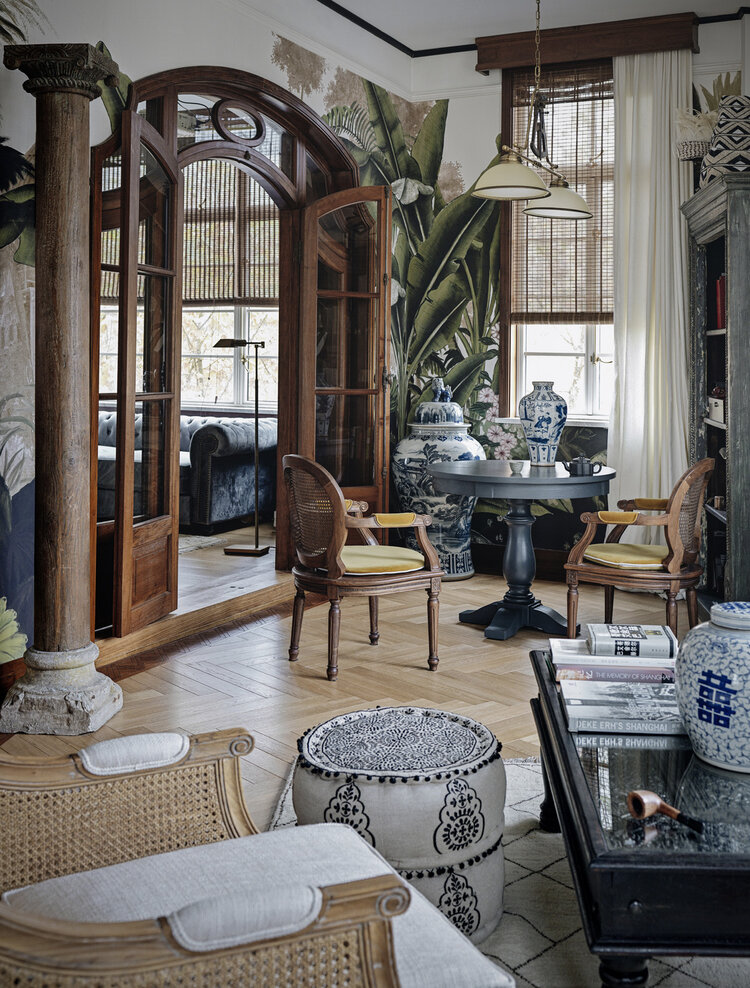
For those hoping to create an impressionable legacy through the spaces we inhabit, the answer can lie closer to one’s roots than we imagine. After all, what is better than culture to teach us about the beauty of heritage? Today especially, thanks to globalization and the multicultural societies we live in, inspiration can come from different cultures and backgrounds than our own. This is why we are dedicating this week’s piece to the various methods and traditions of preserving and maintaining the beauty of interiors across the world.

Japan’s way of embracing imperfections
When talking about Kintsugi, the art of preservation by highlighting the potential beauty of imperfections, we are referencing a long-lasting tradition that dates to the late 15th century during Japan’s Muromachi period. Surprisingly, this method of repairing broken pottery with lacquer mixed with powdered gold, silver, or platinum has been adopted in contemporary interiors across the globe that have found through it a way of valuing the scars of time. We can appreciate the philosophy of Kintsugi through designs that display rough or worn out wooden furniture, exposed brick walls, and raw materials that add character and a sense of history to spaces; turning them into emotionally resonant and welcoming designs.

Maximalism before it became popular
Although maximalism is known as a contemporary bold approach to interior design, it’s roots might be closer linked to a centuries old tradition than to the modern sudden urge to dive into intricate and ornate decor. In fact, various regions of India have been embellishing their interiors with intricate and colorful frescoes, ornate wooden carvings, and unique textiles for centuries. Before Maximalism became a phenomenon, we could find inspiration in the vibrant interiors of regions such as Rajastan, known for its complex wooden carvings and art that remains relevant to today’s interiors in any part of the world. Among the many lessons we can learn from this Indian practice is that beauty can be as complex and bold as we want it to be and still retain a deep meaning and sense of connection to its surroundings.

Interiors that withstand time and climate
Often, when we think of the Mediterranean we also imagine the characteristic white homes with wide doorways and arches that seem to fit perfectly with their natural environment; as if they were always a part of it. This phenomenon is due to the careful planning put into ensuring that the interiors could not only harmonize visually with the Mediterranean nature but also withstand its hot climate. As a result, nowadays we find traces of Greek and Roman influence in the use of whitewashed walls, terracotta tiles, stone arches, and vibrant mosaics that create a timeless and cozy Mediterranean ambience indoors.

The aesthetic and functional sides of luxury
The long history of Middle Eastern cultures can be admired today beyond the walls of palaces and famous villas thanks to the past and current admirers of this stunning design style. Through trade and nowadays globalization, we can also preserve the geometric patterns and intricate tilework known as Zellige, from countries like Morocco. Besides these ornate tiles which also serve to regulate temperature and light, we can also display Middle Eastern luxury with ornate wooden screens known as mashrabiyas, deep, warm colors for different rooms, and lush textiles like silk and velvet that can enrich any contemporary space.

Understanding the popularity of simplicity
The simplicity and functionality that Scandinavian design offers has made it a popular choice for people’s interior decor during these last two centuries. We would not be surprised if this approach outlived the next generations seeing as it boasts of a timeless appeal thanks to the use of natural materials like wood and leather, as well as a strong connection to the surrounding natural landscapes. This connection between space and nature is also one of the reasons why this design style is becoming more and more relevant to restore our relationship with our surroundings. Sometimes, something as simple as open spaces, light-toned wooden flooring, and cozy textiles can provide us the serenity and comfort we need at home.

Maximising the flow of positive energy
Looking back at Chinese dynastic eras and their continuing practices we can draw among these philosophies the principles of Feng Shui and incorporate them in our modern interiors to ensure the balance of energy and harmony within a space. In a more detailed explanation, this traditional interior design practice focuses not only on the aesthetic appeal of a room but also in the way that furniture arrangement can enhance our energy and create a balanced environment. Moreover, we can also take a step further and introduce a visual and symbolic decor with Chinese roots through traditional wooden furniture, silk fabrics, intricate porcelain and ceramic items, or examples of calligraphy in wall art and textiles.

A commitment to sustainability and craftsmanship
In our journey of knowledge we can also learn about the sustainable practices and the connection with the environment that countries like Mali, Burkina Faso, and Ghana display through their adobe architecture. Meanwhile in the case of regions like Botswana and Namibia we also see the use of reed and thatch for the creation of interiors, or decorating methods with textiles such as Kente cloth from Ghana or mud cloth from Mali known as ‘bogolan’. While contemporary design might seem innovative and industrialized, it is not separate from tradition as it is inspired in the same wish to honor craftsmanship and respect for nature. Thus, modern interiors can also showcase elements from the African countries we have mentioned and in doing so, bridging the past and present in a truly unique and unforeseen way.

Looking for authenticity through local sources
Among the countless lessons and principles that Native American cultures from North and South America can teach us, some of these practices can be perfectly related to our own interior design. For example, taking inspiration from the Navajo people who are renowned for their intricate rug weaving, we can look for sustainable, locally sourced materials and crafts that can add warmth and authenticity to any type of design. Or perhaps we can follow the lead of Pacific Northwest tribes like the Coast Salish, and take local woods such as Cedar logs in their case, and turn these into structural and decorative items from reclaimed sources that promote eco-conscious living. Thus by also harnessing natural materials and earthy color palettes as displayed by the Pueblo tribes in their adobe finishes, our spaces can also echo a deeper connection to the land than the one we currently have.

Concluding the lesson
Today’s explanation may end here, however, the lessons that different cultures and peoples around the world have to teach us about the preservation and creation of meaningful interiors is far from over. The above-mentioned examples are only a handful in the sea of traditions and methods revolving around interior design. Therefore we encourage you to take a close look at the spaces you encounter and discover in what ways they too have been influenced by culture and how this enhances the value of an interior.
